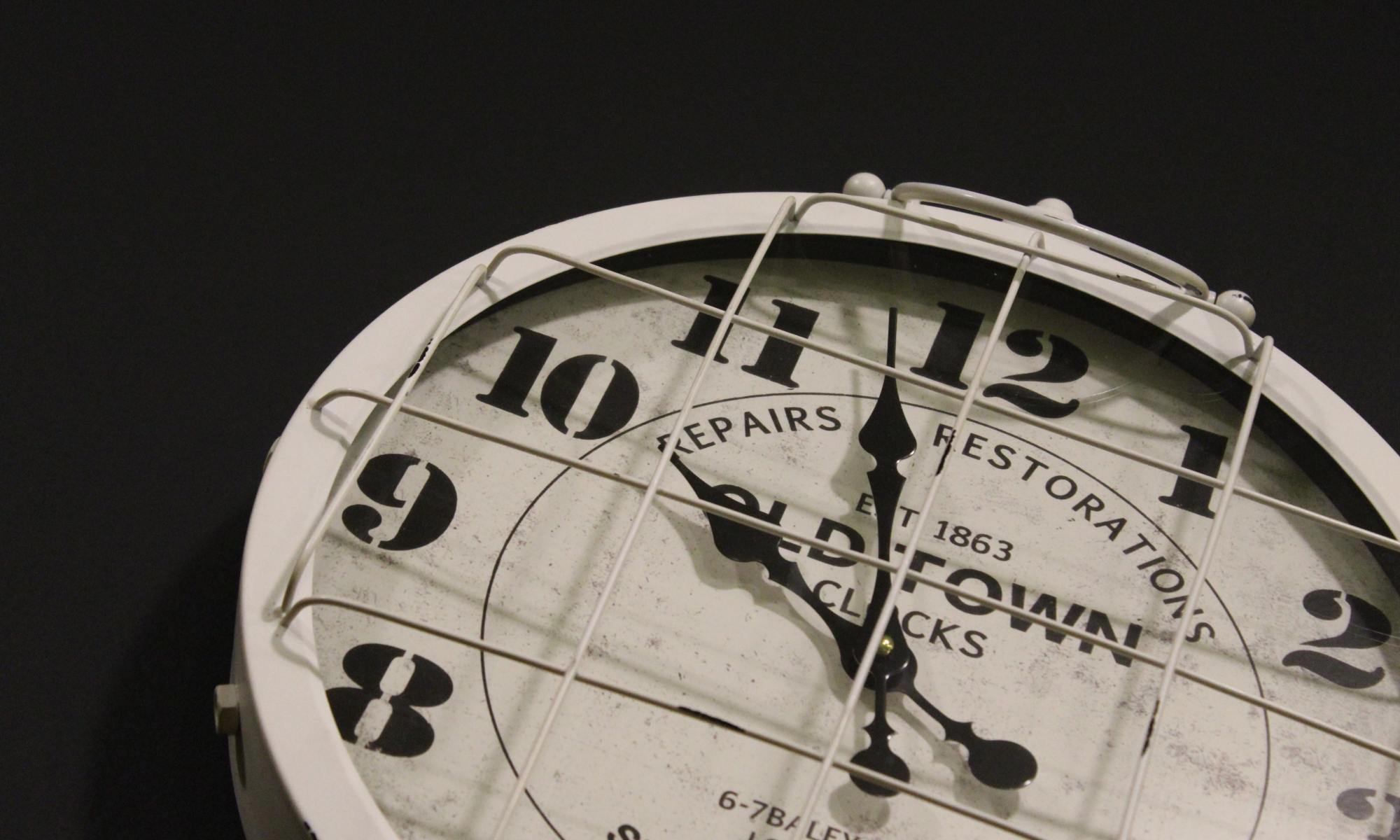
Two obsessions keep finding their way into my writing. Throwing villains off high places, ideally with a protracted death scream. And time travel.
As a glutton for time travel, I’m certainly not alone. The whole world is going nuts for it right now, the concept showing up in more books, movies and TV shows than ever before.
Why? I think there are two reasons. One is that 21st century life is just so fast. The information age has given us so much more to do, but no more time to do it. Time is not just against us, it’s beating us, which is why we crave the ability to control it. Time travel offers relief from the unrelenting pace of life.
The other reason is less deep. It’s just so goddamn fun. It never gets boring because the storytelling possibilities are as infinite as time itself.
But even though more and more writers are using time travel, that doesn’t mean it’s easy. Do it wrong and you can end up with plot holes bigger than a temporal rift. One of the reasons my new book, Million Eyes, took so long to write was because of how much thought had to go into the time travel. It was bags of fun to write, sure, but my god was it hard. And while I’m really happy with how it’s turned out, it took a lot of sleepless nights, alcohol and drawing diagrams of timelines to get there.
For those willing to brave it (and some do say that writing time travel is not for the sane), here are some handy tips I’ve picked up while navigating this precarious path.
1. Choose your mode of time travel—and know how it works
Your first step is obviously, how are your characters going to travel in time? Can they control when they end up? How do they get back? Do they travel in time and space, or just time?
With a physical time machine like the DeLorean or the TARDIS, you just key in the time you want to go to and viola. Much weirder examples include hypnotising yourself (Somewhere in Time) and reading old diaries (The Butterfly Effect). Uncontrolled time travel includes the many temporal rifts in Star Trek, the magic stone circle in Outlander, and the anomalies in Primeval.
In Million Eyes, the characters swallow a pill that displaces them in time. The time travel can be both controlled and uncontrolled. Authorised time travellers have a chip in their heads that allows them to ‘read time’ and select a time to go to. Without this chip, the time travel is uncontrolled and there’s no way of determining when you’ll end up. (Well, there is sort of a way, but you’ll have to read the book to find out!)
Be creative; just make sure you understand exactly how your mode of time travel works.
2. Establish what your time travel rules are
More important than anything is establishing how time travel works in your story and what the rules are. The usual options are as follows.
- The past can be changed and all changes have the potential to alter the future.
- The past can be changed, but changes don’t alter the future, they create a brand-new reality that exists in parallel with the old one.
- The past cannot be changed, and any ‘changes’ are predestined to happen and already part of the timeline.
- The past can be changed, and those changes alter the future, but certain changes made to restore the future are already part of the timeline being restored.
I know—4 sounds complicated. A good example is the Star Trek: The Animated Series episode, Yesteryear. Spock gets deleted from the timeline after his younger self gets killed. Spock resolves to go back in time and rescue himself, then it’s established that Spock saving his younger self was, in fact, part of the original timeline (Spock remembers it). That means he’s predestined to go back and fix things.
Another example is Doctor Who. In the Fires of Pompeii, the Pyroviles are planning to conquer Earth in 79 CE and convert millions of humans into Pyroviles. Because this would drastically alter Earth’s future, the Doctor is forced to stop them. How he stops them is by triggering the eruption of Vesuvius, an event already part of the timeline he’s trying to keep intact.
I use 4 in Million Eyes (I like complicated). I won’t spoil anything specific, but there’s a point where the timeline is changed and the characters go back and fix it, but their actions in fixing the timeline constitute already established events.
Be very careful about mixing up the four options in the same story. 4 is basically a blend of 1 and 3 anyway, but if you want to incorporate 2, you need to be clear why and how. Don’t do what Star Trek 2009 did. That flashy and expensive bit of nonsense told us that Spock and Nero’s time travel had created a new reality, something that was at odds with all prior depictions of time travel in the Star Trek universe.
3. Don’t worry too much about paradoxes and pleeease don’t try and incorporate the ‘disappearing rule’
Part of the fun of writing a time travel story is having a super-weird paradox at the centre of it. Some of the most popular time travel stories are built around paradoxes. The pocket watch in Somewhere in Time is an ontological paradox, where an object gets stuck in an infinite loop and exists without ever being created; Old Elise gives the watch to Richard, who travels back in time and gives it to Young Elise. Similarly, in the Terminator films, Cyberdyne creates Skynet and the Terminators using the damaged CPU from the first Terminator sent back in time. In effect, the Terminators are created from themselves.
But one paradox that writers get really hung up on is the grandfather paradox. The grandfather paradox is the one about going back and killing your own grandfather, thereby erasing your own existence so you’d never be able to go back in time in the first place. This often leads writers to incorporate what I call the ‘disappearing rule’, a manifestation of the ‘erasing your own existence’ part.
Basically, don’t. It didn’t work in Back to the Future, as amazing as those films were, and it certainly didn’t work in Looper. (As I don’t wish to give anyone an aneurysm, please see my article for the Time Travel Nexus if you want to know why.)
My advice would be to follow the rule described by sci-fi author Orson Scott Card: If you go back in time, you can make any changes you want in the past and you’ll continue to exist, because the very act of travelling in time takes you outside the timestream and removes you from the effects of changes in history.
Still with me?
4. Meticulously research any historical periods your characters travel to
I’ve been tripped up by this before. In an early draft of Million Eyes, I described a sycamore tree in 1100-era England—except sycamores aren’t native and weren’t growing there until around 1500. A writer friend of mine, with an evidently better knowledge of trees, noticed.
This is how meticulous you have to be. You have to research everything about the world your time traveller finds themselves in. How did people dress? What did their houses look like? How did they light and heat them? What did they eat? Where did they go to the toilet? What did they do for money?
Also important to remember is how much the English language has changed. Would your time traveller understand what the locals are saying? Early English, Middle English and Modern English are all very different and then there was the Great Vowel Shift from the 1400s, which saw a massive change in how everything was pronounced.
It can be a slog, but it’s worth it. There’s a keen-eyed historian out there just waiting to pick apart your work. Don’t give them the satisfaction of finding anything.
5. Be careful if you’re a pantser
A plotter plans out their novel before they write it. A pantser doesn’t. They ‘fly by the seat of their pants’ and make everything up as they go along.
With Million Eyes, there was no way I could write it without a detailed outline of everything that was going to happen. You’ll see why if you read it. Basically, there are causal loops and predestination paradoxes galore.
Causal loops, by definition, need advance planning, because something your character does at the end affects things happening much earlier—like the Bad Wolf arc in Doctor Who, where the Doctor and Rose are stalked throughout the series by what turns out to be a message from Rose’s future self. If you don’t plan out these kinds of stories, you could end up with something jumbled and disjointed, riddled with continuity and logical errors.
If you’re brave enough to go time travelling in your writing, you’ll have an absolute blast. Just keep these points in mind and remember that, with a time travel book, your readers will already be suspending their disbelief. The trick is to maintain enough coherence and consistency so as not to dangle their disbelief over a ravine.
About the author

C.R. Berry is the author of the time travel conspiracy thriller trilogy, Million Eyes. The first book is out now and available to buy. Described by Berry as The Da Vinci Code meets Doctor Who, it incorporates conspiracy theory-laden events such as the disappearance of the Princes in the Tower and the death of Princess Diana into a fast-paced, twisty page-turner. An accompanying short story collection, Million Eyes: Extra Time, is available for FREE download from publishers Elsewhen Press.
